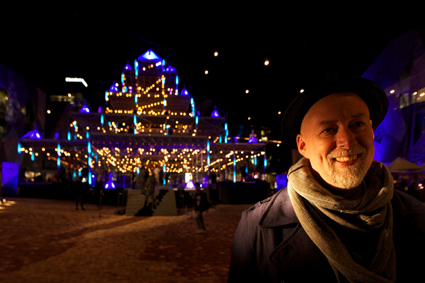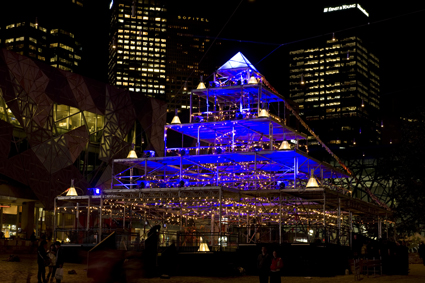 |
Bruce Ramus, Light Hearts, Light in Winter Festival photo Jason South |
Ramus is best known for his pioneering work as a lighting director for leading rock bands, including a 15-year stint with U2. More recently, he has turned his talents to urban design projects, including art installations. Light Hearts is a 13-metre-high pyramid-shaped platform, festooned with more than 2,000 bulbs, video screens and multi-hued strip lights. But its most notable feature is its open invitation to other artists and members of the public to contribute to the work. I spoke to Bruce Ramus a few days after Light Hearts opened.
How did you begin working with light?
My mum was an amateur actress, so I spent a lot of my youth hanging around community theatres and just kind of watching that process of how light affects how I feel about what I’m watching. The process is, I think, really visceral, really in our bodies. That’s where we really get it…it’s not something that happens cerebrally.
It seems to me that there was a big change in the music industry through the early and mid-90s with the integration of video into the stadium rock event in tours like the Rolling Stones’ Wheels of Steel and U2’s Zoo TV.
For me, certainly, the tour was Zoo TV. Prior to that, video had been a peripheral part of large-scale rock concerts. It largely sat on the outskirts of the stage. Zoo TV is when we took the screens and the imagery and moved it all to the centre of the stage. We made five large video walls and had about 200 televisions dotted around the set in groups of twos and threes, making one large, albeit fractured, canvas. The whole idea was a media barrage.
What difference did it make to your role as the lighting director with so much ambient light coming off a large bank of screens?
It allowed the lighting system to do less, so that I could turn it off and let the screens run. I learned to lay back and let the video do the work. And that was really beautiful, because when I did join in, it had a much stronger effect. As it is in any medium, the less you use it, the more powerful it is.
It would have been a few years after ZooTV, I guess, that LED started to become a viable video format?
In 1996, we wanted to develop a new type of video system. At the time, there existed a red and a light green LED, like we see on little power switches on our amps and our microwaves. So we asked Saco in Montreal if they could build blue and a full spectrum green LEDs, which they did. We then took that to Innovative Designs in Belgium and they made the prototype module which became the first ever LED video screen. Then we toured it in 1996-97 on the PopMart tour, which was the largest video screen yet built. It was about 70 metres wide and about 25 metres tall.
On that tour we did 130 shows for over two years, all outdoors. And I watched every audience walk out of there slack-jawed and stunned. Which was not my experience on Zoo TV, where they were vibrant, engaged. It really made me think about why this was happening. I noticed myself that I was watching the screen more than the band. So, there was a problem there.
Since then I have learned that when there is a higher resolution, there’s very little gap in the pixels, so the brain of the viewer does nothing to understand the image. The image just floods in. It’s a very passive experience. But when you start to separate the pixels, the brain automatically has to make up the gap. So it becomes a much more active experience for the viewer. Where on PopMart it was a bit like a music video. You know, we’re cutting to this, cutting to that on the beat, on the guitar solo, you see the strings of the guitar…no energy, a bit numbing.
 |
Light Hearts, Light in Winter Festival photo Fred Kroh |
That’s great. Yeah, you get it. The ritual for me is indeed a part of how I design anything…in terms of the history of theatre and how that began as a ritual of transformation. For me, those ceremonies and rituals are why we attend these events, because we all somewhere believe that there’s a potential, however small, for personal transformation. So, that’s how I began thinking about this.
I was asked to come up with an idea to unify the festival. I did want to build a framework for activities and for people to gather in the day, so that it just wasn’t something that sat there and came alive at night and had no role in the day. And so I started to consider a structure and immediately the pyramid came to mind.
You know, the word ‘pyramid’ has many translations, but the one that resonated for me was from the Greek ‘pyra,’ as in pyre, meaning a measurement of fire or light. And then I started to look deeper into why the pyramids were built, the great pyramids in Egypt, and found a lot of consensus on the building of them as an energetic healing symbol. This just kept deepening my connection to this shape and this structure. And a further aim was to make it light-hearted so that anybody could come and respond to this. Anyone could come and build a lantern or tie a piece of fabric on it or, there are so many ways to address it.
Every Saturday we build lanterns with children. It’s just fantastic to see. And then you start to see the other side of light, the light in the child’s eyes when they get to create something, leave their mark on an urban landscape, become part of something bigger.
How would you compare the work here with the way in which an audience participates in a rock event?
In a large stadium or in any show, you know, the audience is very controlled. They aren’t necessarily aware of that, but as the ones who push the buttons with the lights and the video, we have a level of influence on where everyone looks, how they will feel at any given time. With this, it’s much less controlled and it feels really interesting to have that…You know I’ve contacted artists like the Yarn Bombers. Today, I’ve spoken with a graffiti artist who’s coming tomorrow to begin painting some of the bits. And I don’t really know what they are doing and I’m just letting that happen.
How does that work for you? Because as a lighting director you’ve usually got to be really in control.
Yeah, it’s true. There are elements of this that I have controlled quite tightly. There is a lighting system installed on the pyramid, and we programmed it so it has a set of scenes or cues that it runs every night. And it runs through those from 5pm to midnight and then goes into its resting state, its breathing state, which is just one breathing cue that goes to 6am. So that part of it is quite strictly controlled. But then there is this whole interactive element to it. And the one thing that I’m finding more and more important in all of my installations is this interactive element. People do it with their bodies. It’s not something that you have to think about necessarily. You just go in, you can do something with your hands and put it on the structure. That was really important for me, to be able to let control go, give it to the people who wish to engage with it and let them do what they wish.
It will be interesting to see how people just appropriate the space themselves.
Yeah and I’ve seen that happen at night, when there’s no set agenda. The jazz festival was on and there were about 25 young people and they were all dancing around the bottom level of the pyramid…holding hands and swinging and running around the central core…magic. I just loved to see it.
Federation Square’s The Light in Winter, Melbourne, June 2-July 3
RealTime issue #104 Aug-Sept 2011 pg. 33
© Scott McQuire; for permission to reproduce apply to [email protected]








 back
back